




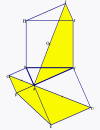
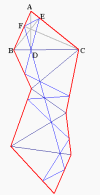
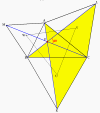





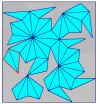


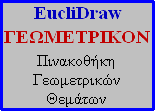
|
|
About me
Born in Athens Greece. Studies in Athens, Bonn and Cologne.
Ending with Ph.D. in Differential Geometry under the supervision of
prof. Peter Dombrowski. I had various assistant, researcher and
visiting-professor positions in
european universities,
now holding an associate professor position at the
university of Crete, department of Mathematics . I enjoy
teaching, programming,
and (in the, not often, free time left) doing my
parerga.
I speak Greek, German, French, English,
Italian and Russian.
Main interests
Mainly interested in Geometry, Programming, teaching on these and related
mathematical subjects, and thinking on all that and what globally happens to me and to the world i.e.
on Philosophy. Quite early, from the school, I had a lot of fun with Euclidean Geometry, then, as a
student and researcher, moved to Differential
Geometry, Mechanics and Lie Groups, and in the last ten years returned back to Euclidean Geometry
and its presentation through the computer (Dynamic Geometry). These activities are reflected in
publications of papers , books
and computer-programs. Presently the focus of my activity, is the construction
of a program which enables the design of dynamic plane figures. The first,
static, version of this program, called Isoptikon®
is available through the Internet in the free software domain since 1996.
Most of the figures you see on the left sidebar were constructed by this
program. The result of my recent work is the dynamic version of it, called EucliDraw®. You can free download and use in your work. My actual activity extends on various aspects of Dynamic Geometry, practical as well as
theoretical. The introduction of numerical and/or formal calculations in Geometry, and the resulting possibility of dynamic changes of figures, introduces lots of problems that must be considered in a theoretical framework.
I hope to be able soon to discuss, in these pages, some of these problems, as well as the theoretical basis upon which EucliDraw was constructed.
Lecturing
I enjoy lecturing on various subjects of Mathematics that I (think that)
understand. I like explaining something I know, studying examples and
solving problems. In the last thirty years I had a continuous
activity in teaching on these subjects: Euclidean Geometry, Hyperbolic
Geometry, Differential Geometry, Linear Algebra, Group Theory, Lie-Group
Theory, Algebra, Analysis, Calculus, Complex Calculus, Differential
Equations, Topology, Algebraic Topology, programming in Fortran, in C
and C++. The notes on Maple ,
HTML , C++ , Group Theory
and Euclidean Geometry I present here, are in Greek and serve as orientation for the lectures I hold presently.
Some additional pages on problems and exercises in Geometry are published in the web
Gallery of Geometry Problems (english).
Isoptikon®
This is a program to draw figures of theorems of plane Euclidean Geometry.
The program was initially dedicated to a class of
geometrically defined cubic curves (isoptics), with abundant geometric and
algebraic properties. Having constructed the basic libraries to support the
design on the computer, I started to use the program in my lectures, adding
from time to time a new feature. Thus, the whole thing evolved to an
instrument for exact drawing of geometric figures. In 1996 I put the first
version on the Internet to make it free available for my students. This first
version was for the Macintosh platform. After two years I had also the windows
version. Both of them now free available, can be downloaded here:
"Isoptikon for Macintosh"
"Isoptikon for Windows-98"
The program can be of interest to everyone who learns or teaches Euclidean Geometry. Together
with his help, samples and tutorials, it occupies 1.5 Mb of disk-space.
Click here
to see a screen snapshot of it. Visit the Gallery to see the pictures of the sidebar in full size.
EucliDraw® and Dynamic Geometry
EucliDraw® is a program that, like Isoptikon® , enables the precise drawing of dynamic figures of plane
Euclidean Geometry. It adds however many features, allowing a more complete study of the figures. First the figures are dynamic.
F.e. A triangle with its medians. You can change the shape of the triangle, but the medians are drawn correctly in the new
position. Second the application, next to its main drawing-environment, has an integrated programming-environment. There you can write small programs (scripts) to create new tools of your own. Thus you can extend
the application, become independent of me and eventually sell back to me your tools. All these wonderful things may start to hapen right now. Presently you can
download
the full program and use it free. I would also be very pleased to recive comments and criticism from those
that will spend their precious time working with this tool. I hope that they will do it at leisure and enjoy with it some nice trips in the wonderful world of Geometry, Computing and Programming.
The proper framework for this program is that of Dynamic Geometry. In fact there are several other interesting
programs in the market, doing similar work. The stress in EucliDraw is on its ability to produce
quickly complicated figures and minimize/eliminate the work of preparation. Thus it can be used in the class
to construct the figures of theorems and motivate proofs and further investigations. The teacher,
after a short period of training, does not need to prepare any documents at home. He can do it in the class, without
to spend much time for the construction of figures. The reason for this is that the program is founded not on
the narow set of axioms of Euclidean Geometry. It uses instead a considerable wider (than the axioms)
conceptual granularity, implementing in its foundations far more shapes than the elementary of line and circle.
Programming
Programming is a beautiful and dangerous activity. Beautiful because you create things.
Especially when your creations are useful to other people. Dangerous because it becomes more and
more demanding on you as the programm grows beyond dimensions. From the philosophy's point of view,
a program is nothing more than a system of very well organized thoughts about a concrete subject.
With the help of a programming language you standardize this system and give it away to be used by
other people. I'll come back to this in my philosophical parerga.
I consider programming as a research activity. You find a path to standardize your thoughts.
You inspect the available knowledge, you decide for the tools to use and try to realize something
new. The pattern is the same with the one of discovering a new theorem. I do with pleasure both
jobs, but find more valuable to create a system facilitating the discovery of new theorems,
by me and by others, rather, than to discover a few new theorems. A beggar wanted once Confucius
to give him a fish to eat. Confucius taught him fishing. More on this again in my parerga.
Geometry
Geometry is the source of most mathematical ideas. For some 2000 years the body of mathematics
was essentially Euclidean Geometry and its ramifications. Euclid organized the knowledge of his
time in a synthetic way. Everything was founded on the axioms, which are properties of the plane
or space accepted without a proof. Then one considered the consequences of the axioms and consequences of
the consequences etc.. Nowadays we work more with coordinates and models. In fact, since Descartes
we invent general methods to translate the geometric properties to formulas and vice-versa. In this
way we loose the flavour of abstract, synthetic geometric reasoning but we gain the generality of methods
and hints to their extendability to more general questions. F.e. a crucial step in the evolution
of Geometry was the generalization of plane Euclidean Geometry to arbitrary smooth surfaces (like
a sphere). This led to Riemannian Geometry and the explosion to an infinite multitude of Geometries.
Geometries where the only reasonable tools are those of mathematical analysis, algebra and topology.
Today research in Geometry is mainly concerned with the groupping of various geometries after
some criteria, dictated by the nature or some clever mathematical brain. Another concern is
the investigation of various properties which seem trivial in Euclidean Geometry, but are very important
in other geometries. F.e. how behave "lines" in various geometries? how rapidly grow the spheres
centered at a point, when their radius changes?
I, for my part, love the "concrete" and the
"figure". I want to see the relations rather than calculate them. A nice geometric figure has
a mathematical and an aesthetic appeal to me. Thus I like to use mathematical analysis and
the computer to visualize concrete complicated figures. This was also the motivation to start
programming in Geometry. Thus I started from Euclidean Geometry, plan to go to hyperbolic geometry
and if still alive and in good health, even further to geometry of surfaces and Riemannian Geometry.
Admittedly the velocity of the realization of my plans is inversely proportional to their extend.
But I try allways to produce nice figures, "Musikin poiei kai ergazou" (deal with harmony and work) as the spirit suggested
to Sokrates short before his execution.
Philosophy
It seems to me that the most important philosophical problem is to find out whether there is
a meaning in life and all this that happens, or everything is meaningless and after the
small period of youth finishes in painful disaster.
The laws of Nature are the only thing that has an absolute validity. They never
fail. They are like a river and we are thrown therein and must swim and survive. We are not
asked if we like that or not.
I would never act that way with my friends, even with my pet. This is not a good pattern to
create good relations with people and living beings. Nevertheless this is what happens, and
if we think a little more, we see that we too do act after this same pattern.
In fact, our will is not very powerful but imposes some laws and directives for people and
animals next to us and, some times, far from us. In some sense we are tiny little sources or
rivers, from which some others must drink or swim, correspondingly. So the sublime cruelty
is reproduced in a very small scale.
From these simple observations one comes to the result that we too are a kind of small
worlds living, exercising power and dying like the stars and the planets in the immense
universe. One could say that, in general, violence and pain is prevailing.
Leaving the subject of violence for a later discussion, I come to these tiny lows or worlds
that we represent. How they are formed? Are they the result of some kind of volcanic activy,
an eruption? Which is the consistence of the hard surface? Which is the consistence of the
burning interior? Are our eruptions and earthquakes predictable? Which are their laws?
How they were formed? Can be changed? To which direction? Must they conform to the big laws?
In what extend? etc. etc.
Could these questions be answered? Should one bother about these matters? Isn't better to make
travels, tourism, relieving his spirit? Perhaps, if there is one at all, it depends on the kind of spirit.
I find though boring all these travels and doubt greately if one can by these
be helped in its despair to find satisfaction. In most cases the tourism is a poor substitute of
an undiscovered world which marches to its end, without being ever noticed. It is a strange
phenomenon to have a world that near to you and at the same time that far,
that its light does not reach you in your lifetime.
So these things interest me and I will come back to think about them, and intend to write
something also in these pages. In Greece living and thinking you feel the responsibility to
absorbe an incredible amount of philosophical work of your ancestors. Then you have to say
your own words. The Greek language has developed a reach structure to express yourself in
these matters. So I will turn next to this language and translate later the subjects asked on
by friends. Here is the english version of my parerga, that have been
translated so far.
| Copyright© Paris Pamfilos 2002-2019 | last update: 14/05/2019 |
| See me, (pamfilosATmathDOTuocDOTgr) |
|
Εισαγωγή στη
Γενική τοπολογία
Η Ευκλείδεια Γεωμετρία
στην εκπαίδευση
|
Geometrikon |
| Βιβλίο Ευκλείδειας Γεωμετρίας Γεωμετρικόν |
Ελληνικό
Πρόγραμμα
Σχεδιασμού
Ευκλείδειας
Γεωμετρίας
Bach
Vivaldi
Glenn Gould
| Yiu Introduction to Geometry 2013 |
